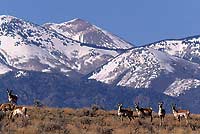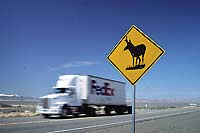Faster than a speeding bullet they are not. But try to outrun one and you’ll be eating dust. The American pronghorn, sometimes called pronghorn antelope, are the swiftest land mammal in the Southwest. Able to run at speeds up to 70 miles per hour, they can maintain a steady 35 mile per hour pace for a long distance. So don’t even try to race one.
Their large heart and lungs, strong leg bones, powerful muscles and padded hooves to absorb shock when running help these desert dwellers escape danger. Exceptional eyesight also aids their early warning detection system. The eyes protrude from the side of the head and provide a unique wide angle view; pronghorn can easily spot a predator 3 miles away. When alarmed, the animal raises 3-inch-long hairs on their rump so that a large white rosette forms and this signal may be seen by others.
 Like deer and elk, pronghorns are ungulates or hoofed mammals. They are the lone member of their own family known as the Antilocarpidae; their scientific name Antilocarpa americana means “antelope-goat of America.” They feed on forbs and shrubs, at times getting their water needs met by succulent wildflowers especially in spring and summer by does and fawns.
Like deer and elk, pronghorns are ungulates or hoofed mammals. They are the lone member of their own family known as the Antilocarpidae; their scientific name Antilocarpa americana means “antelope-goat of America.” They feed on forbs and shrubs, at times getting their water needs met by succulent wildflowers especially in spring and summer by does and fawns.
Named after their horns, the males have a 10-20 inch long horn that has a small bump or prong that points forward. The rest of the horn curves backwards and slightly inwards. Unlike deer and elk which have antlers that are shed each year, the pronghorn’s horn is a bony core that is surrounded by a sheath of specialized skin and fused hairs. The hollow sheaths are shed each year in winter and new ones grow back by mid-summer. The female, known as a doe, also have horns, but they are smaller than the male’s horns.
 The males, known as bucks, use their horns to joust or battle with rivals. Sometimes the bucks jostle shrubs with their horns; this isn’t battle practice but a way to leave their scent mark on vegetation to delineate their territory.
The males, known as bucks, use their horns to joust or battle with rivals. Sometimes the bucks jostle shrubs with their horns; this isn’t battle practice but a way to leave their scent mark on vegetation to delineate their territory.
Animals of open grasslands and the plains, pronghorns frequent areas where surface water exists especially during dry periods. In the Cisco Desert, bisected by Interstate 70, and on Hatch Point, south of Moab, there are herds of pronghorn that originated from animals being released in the late 1960s and early 1970s. The animals rely on ponds and ephemeral streams to provide water for drinking. Though both herds have grown since their original releases, drought and harsh winters, and disturbances and predation are several factors that impact their health.
But things weren’t always this way. During the time of the Lewis & Clark Expedition to the Pacific Ocean an estimated 35 million pronghorn roamed across the western interior of the new nation. Hunting, livestock, and land conversion followed and by the early 1900s an estimated 13,000 animals remained.
 States were quick to ban hunting or trapping of pronghorns and for 50 years these animals responded to those protections and populations rebounded. Unlike deer which may bound over fences, pronghorn have to crawl under the wire. They quickly learn where arroyos or erosion cut the deepest trenches. Current grazing practices mandate clearance of at least 16” to provide passage for these magnificent creatures.
States were quick to ban hunting or trapping of pronghorns and for 50 years these animals responded to those protections and populations rebounded. Unlike deer which may bound over fences, pronghorn have to crawl under the wire. They quickly learn where arroyos or erosion cut the deepest trenches. Current grazing practices mandate clearance of at least 16” to provide passage for these magnificent creatures.
During April, the large winter herds begin to splinter, forming smaller groups. Traveling across Interstate 70 or along Highway 191 cuts through pronghorn habit and, in places, offers a chance to view these “prairie ghosts” with their blinding speed and subtle coloration. Keep an eye open for their presence, but don’t try to catch them. You’ll only end up with a memory.

 Like deer and elk, pronghorns are ungulates or hoofed mammals. They are the lone member of their own family known as the Antilocarpidae; their scientific name Antilocarpa americana means “antelope-goat of America.” They feed on forbs and shrubs, at times getting their water needs met by succulent wildflowers especially in spring and summer by does and fawns.
Like deer and elk, pronghorns are ungulates or hoofed mammals. They are the lone member of their own family known as the Antilocarpidae; their scientific name Antilocarpa americana means “antelope-goat of America.” They feed on forbs and shrubs, at times getting their water needs met by succulent wildflowers especially in spring and summer by does and fawns.  The males, known as bucks, use their horns to joust or battle with rivals. Sometimes the bucks jostle shrubs with their horns; this isn’t battle practice but a way to leave their scent mark on vegetation to delineate their territory.
The males, known as bucks, use their horns to joust or battle with rivals. Sometimes the bucks jostle shrubs with their horns; this isn’t battle practice but a way to leave their scent mark on vegetation to delineate their territory.  States were quick to ban hunting or trapping of pronghorns and for 50 years these animals responded to those protections and populations rebounded. Unlike deer which may bound over fences, pronghorn have to crawl under the wire. They quickly learn where arroyos or erosion cut the deepest trenches. Current grazing practices mandate clearance of at least 16” to provide passage for these magnificent creatures.
States were quick to ban hunting or trapping of pronghorns and for 50 years these animals responded to those protections and populations rebounded. Unlike deer which may bound over fences, pronghorn have to crawl under the wire. They quickly learn where arroyos or erosion cut the deepest trenches. Current grazing practices mandate clearance of at least 16” to provide passage for these magnificent creatures.